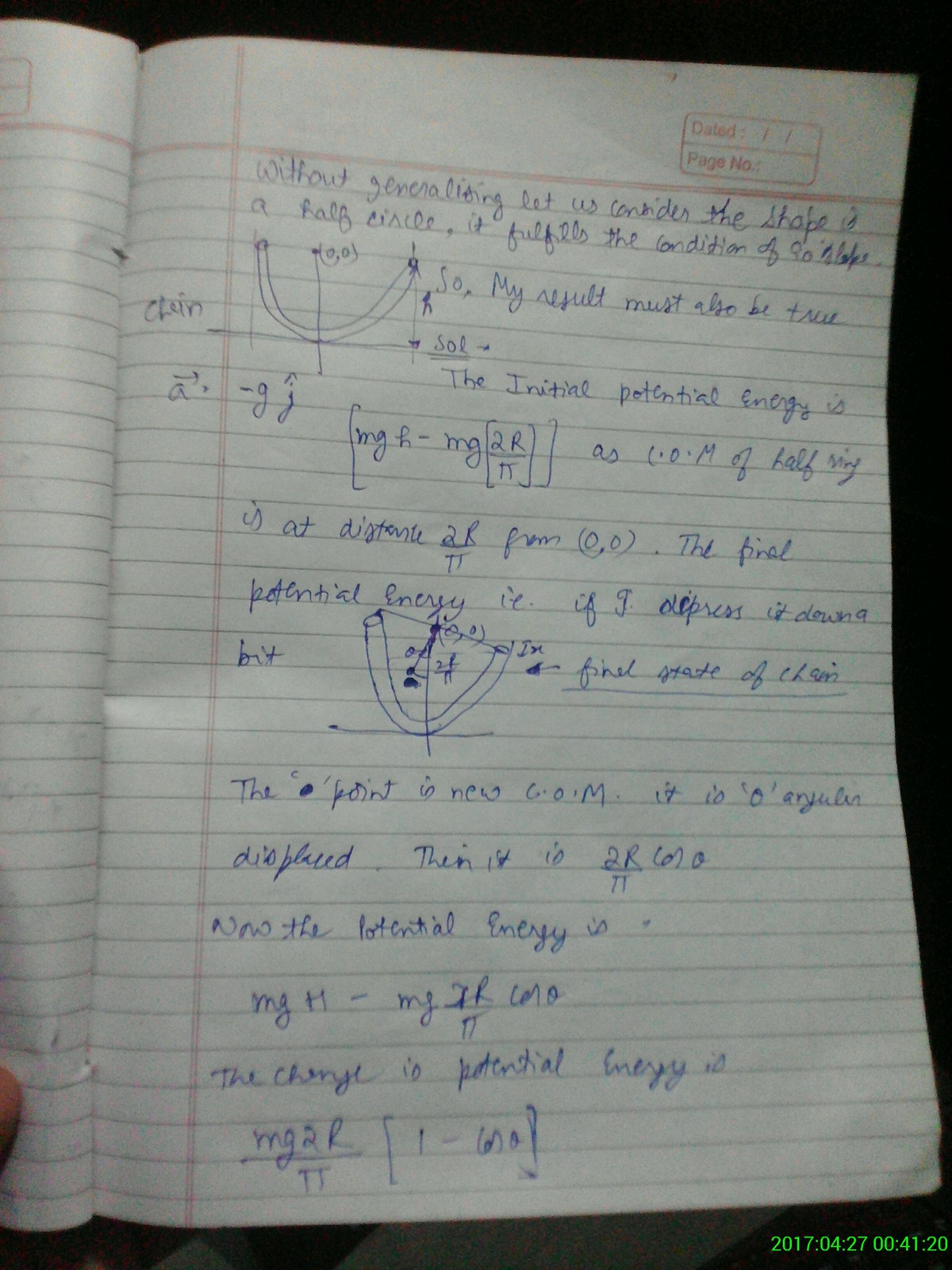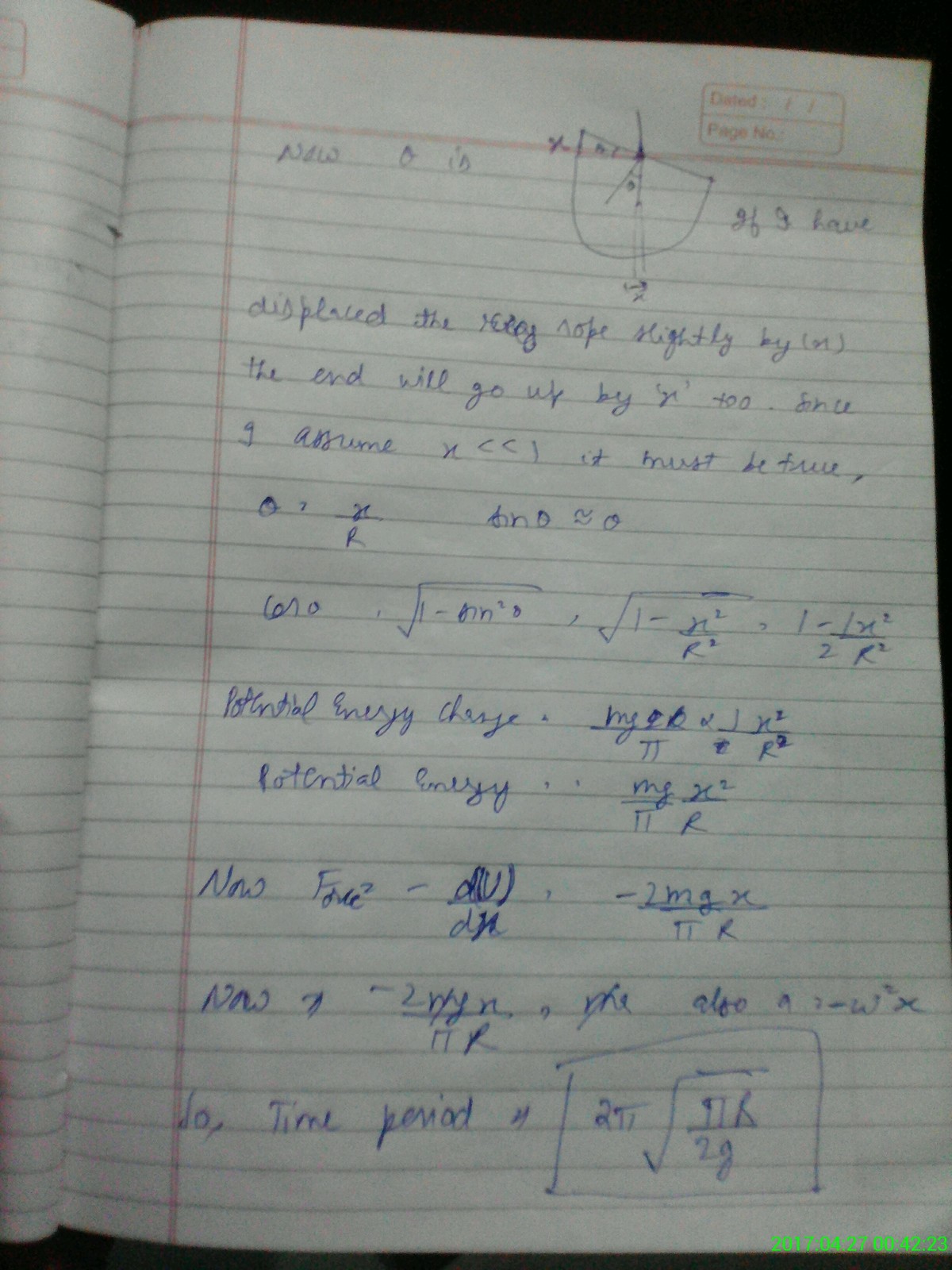Rope in a circular tube
A rope of mass M having length π r is placed in a vertical circular tube centered at the origin. The mean radius of the tube is r = π 3 2 0 m . The width of the tube is such that it just fits the rope.
The rope is slightly pulled from one end and released to oscillate. If the tube is frictionless, find the time period (in seconds) of the small oscillations. ( Take acceleration due to gravity g = 1 0 m / s 2 . )
The answer is 2.
This section requires Javascript.
You are seeing this because something didn't load right. We suggest you, (a) try
refreshing the page, (b) enabling javascript if it is disabled on your browser and,
finally, (c)
loading the
non-javascript version of this page
. We're sorry about the hassle.
4 solutions
Wow, this is a beautiful solution. Looks like you've come full circle with LM.
Log in to reply
level 4 ? really ?
see my solution plz , it's beautiful too.
i solved using some creativity :)
Log in to reply
It's always fun to see the various ways of solving problems
Log in to reply
yeah ! beauty of physics :)
Great solution. Thanks!!!
Sir, do you mind listening to what I did?
As we will obviously displace the rope a bit to check the time period...... but if we notice .... then the center of the rope will be fixed, So taking rotations about the center, we can say, For a half ring,
MOI = M R 2 and the time period of a compound oscillations = T = 2 π M g d I where d is the dist. from COM from the point of rotation.
Now we can say that, d = π 2 R and I = M R 2 .
Am I correct sir?
Well got the same answer, But I love physics, I am very precautious if I was correct, rather than just making up the answer anyhow.
Thanks for your time :D.
I will eagerly wait for your reply.
Log in to reply
Now that I look at this again, it could be fairly easily done using the torque and the moment of inertia, as you appear to be doing. So I think you're right.
Log in to reply
Ok thanks. Well. What is lagarangian mechanics? Where can I study that?
Log in to reply
@Md Zuhair – Here's Brilliant's article on it:
https://brilliant.org/wiki/lagrangian-formulation-of-mechanics/
Log in to reply
@Steven Chase – Thanks sir.
Log in to reply
@Md Zuhair – I'm looking forward to solving your first LM problem when you post it :)
Log in to reply
@Steven Chase – Sure Sir! :D. By the way, Do you like my problems sir?
Why don't you convert this into a solution? This is the standard force method with which I solved this too. :)
Log in to reply
Which method? Steven sir's method?
Log in to reply
@Md Zuhair – No, yours. Steven sir solved it via the potential energy method then calculated force by differentiation. Whereas torque can easily be found and equated to τ = − c θ
Log in to reply
@Tapas Mazumdar – Actually :). Are you prepared for Boards Nd JEE?
Log in to reply
@Md Zuhair – Right now focusing on boards English paper. Will divide time for mains and boards after my physics paper.
Log in to reply
@Tapas Mazumdar – Oh.. I have class 11 English too!
@Md Zuhair Why don't you post that as a solution , the solution was very good , I really didn't notice that com was fixed and we can treat it as a compound pendulum..Though I too solved it using some similar analysis of torque.
Log in to reply
:D Sure bro. I will, Let my exams come to an end :p , It would take 3 more days :D
Log in to reply
@Md Zuhair – All the best for your exams. :)
Log in to reply
@Ankit Kumar Jain – Most of them are over, Only maths and CS are left. Btw, Thanks for that :D
This is an incredibly elegant solution, thank you!
Thanks. I just happened to notice that this is the 2-year anniversary


u can do it using taylor theorem ,
by calculating potential at general displacement and double differentiate it to get the value at the eqil. point ,
hope i'm right and u liked it.
Awesome solution!!!!!
Log in to reply
at least upvote it then :P
Log in to reply
Ya....sorry forgot to up vote. Now I have up voted.
Log in to reply
@A Former Brilliant Member – thnx , btw isn't my creativity good ? :) btw i don't know if my ans is right or not @Prakhar Bindal @Mark Hennings @Aniket Sanghi can u check the answer plz :)
Log in to reply
@A Former Brilliant Member – I got your answer. Very nice problem. I solved using Lagrangian Mechanics.
Log in to reply
@Steven Chase – Can you post your approach? thanks in advance
Log in to reply
@A Former Brilliant Member – Yes, I will post it later
@A Former Brilliant Member – It's up now. @Josh Silverman , this was a nice application for LM.
@A Former Brilliant Member – Yes.....you are very creative.
@Spandan Senapati is my answer right ? u r supposed to deal in olympiad - type problems , is it apho level ? i made it today morning :P
Very nice problem! Post more bro!
Great jobs all around-I love the problem. And a nice solve too.
Log in to reply
thnku sir , btw shouldn't it be level 5?
Nice problem! Did the same way :p
Log in to reply
how's adv prep ?
Log in to reply
Still not thorough ! Feeling the heat :(
Log in to reply
@Sumanth R Hegde – me too but u'll do fine :)
Log in to reply
@A Former Brilliant Member – i got 130 marks in mains , will i be even able to clr adv :(
Log in to reply
@A Former Brilliant Member – Worst part is that it always comes down to what you do on the day of the exam, ! U give in to pressure and boom, there goes everything.
Log in to reply
@Sumanth R Hegde – And BOOM! You are now in an IIT! I don't know why, I get an "ajeeb" feeling when I think, If I get into IIT. That AJEEB is just a very good feeling. I love that feeling, that "Yeah! I got into the IIT!" .. You got that.
Its our turn now :D.
Just keep us blessed, We will end up at IITM only :P
HAHA. I heard IITM mess gives awful food? I heard, I dont know
we can easily do it with com concept. i.e distance of com of ring from centre is 2R/pi .Mg as restoring torque acts there is displced at small angle theta.mow use T=I*alpha .here I is MR^2
Why I = 2 M R 2 , wouldn't it be I = M R 2 ?
Log in to reply
It is a ring, not a disk
I is MR² only my bro.
oh.. sorry corrected now
I will attempt to draw an analogue to the spring harmonic oscillator to solve this problem.
-Given small displacement θ on one side, we will have additional mass π 2 θ m on that side as well and restoring force
F = π 2 θ m g
-Using the middle of the rope as a point of reference, the linear displacement d follows the relation relation with d = r θ which we can substitute into the previous equation to rewrite the restoring force
F = π r 2 g m d
-Recall the spring harmonic oscillator which had restoring force k d and period
T = 2 π k m .
Our restoring force has the exact same form, just with a different k! Substituting in we get
T = 2 π 2 g π r
Plugging in radius and gravity we get
T = 2 π π 3 2 ∗ 1 0 π 2 0 = 2
The rope is a semi-circle of radius R. Suppose the midpoint of the rope segment is offset from the vertical by an angle δ . The mass associated with an infinitesimal portion of the rope is:
d m = π d θ M
The height ( y ) above the lowest part of the tube is (where θ is the angle between the infinitesimal and the vertical):
y = R ( 1 − c o s θ )
The gravitational potential energy of the infinitesimal is:
d U = d m g y = π d θ M g R ( 1 − c o s θ ) = π M g R ( 1 − c o s θ ) d θ
Recalling that the midpoint of the rope segment is offset from the vertical by an angle δ , the gravitational potential energy of the entire rope is:
U = π M g R ∫ 2 − π + δ 2 π + δ ( 1 − c o s θ ) d θ = π M g R ( π − 2 c o s δ )
As the rope segment oscillates, the offset δ will vary with time. The associated kinetic energy is:
K E = 2 1 M v 2 = 2 1 M ( R δ ˙ ) 2 = 2 1 M R 2 δ ˙ 2
We can solve for the dynamics using Lagrangian Mechanics . We have one state variable ( δ ) . The system Lagrangian is:
L = K E − U = 2 1 M R 2 δ ˙ 2 − π M g R ( π − 2 c o s δ )
The Euler-Lagrange equation is:
d t d ∂ δ ˙ ∂ L = ∂ δ ∂ L
Evaluating the left-hand side yields:
d t d ∂ δ ˙ ∂ L = d t d ( M R 2 δ ˙ ) = M R 2 δ ¨
Evaluating the right-hand side yields:
∂ δ ∂ L = d δ d ( π 2 M g R c o s δ ) = − π 2 M g R s i n δ
Equating the two yields:
M R 2 δ ¨ = − π 2 M g R s i n δ δ ¨ = − π R 2 g s i n δ
Assuming the initial angular displacement is small, the following approximation can be made:
δ ¨ ≈ − π R 2 g δ
This differential equation clearly corresponds to simple harmonic motion with angular speed as shown below:
ω 2 = π R 2 g = T 2 4 π 2 T = 2 g 4 π 3 R
We are given the value of R:
R = π 3 2 0
Substituting in for R and ( g = 1 0 ) yields:
T = 2 0 π 3 4 π 3 2 0 = 4 = 2